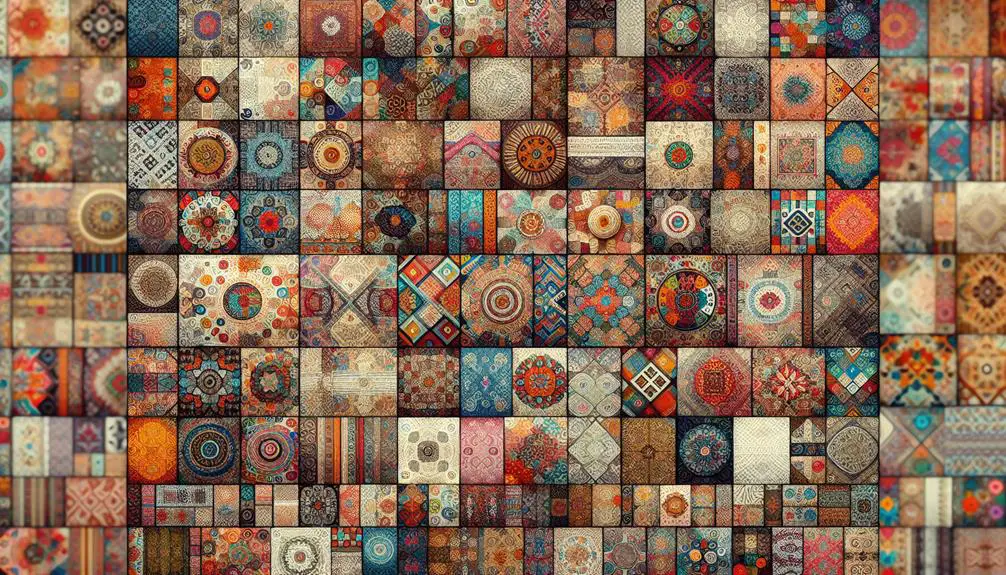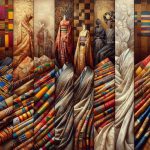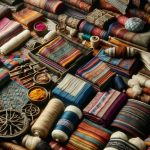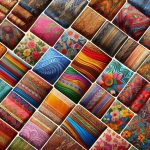Exploring traditional fabrics is a journey through history, a connection to culture, and an appreciation of artistry. When you look at African Kente cloth or Japanese kimono fabrics, you don't just see colors and patterns; you witness stories and traditions. Indian silk saris and Peruvian alpaca textiles offer more than just beauty; they embody regional expertise and sustainable practices. As you consider Thai silk weaving, Indonesian batik patterns, and Moroccan Berber wool rugs, you start to understand how these fabrics serve as cultural bridges. What unexpected tales will these textiles reveal to you?
Table of Contents
Key Takeaways
- African Kente cloth features vibrant colors and patterns that symbolize wealth, beauty, and historical narratives.
- Japanese kimono fabrics use traditional dyeing techniques and motifs that reflect prosperity, beauty, and seasonal meanings.
- Indian silk saris, handwoven with intricate regional designs, are integral to cultural heritage and significant life events.
- Peruvian alpaca textiles offer luxurious softness and warmth, showcasing artisanal weaving techniques and sustainable fashion practices.
- Thai silk weaving preserves cultural heritage through traditional looms and sustainable practices, blending old techniques with modern designs.
African Kente Cloth
Originating from the Ashanti Kingdom, African Kente cloth stands out with its vibrant colors and intricate patterns. Each hue and design holds deep meaning, making the fabric much more than just a piece of cloth. When you look at the bold colors, you're not merely seeing a pattern; you're witnessing a story.
For instance, yellow often symbolizes wealth and beauty, while blue represents love and harmony. The intricate patterns woven into the fabric aren't random; they convey proverbs, historical events, and philosophical concepts.
In traditional ceremonies, Kente cloth plays a pivotal role. Whether it's a wedding, a funeral, or a festive celebration, draping yourself in Kente isn't just a fashion statement—it's a nod to heritage and identity. You'll find that these ceremonies are rich with symbolism, and the Kente cloth enhances this richness.
Modern fashion trends have also embraced Kente cloth, integrating it into contemporary designs. From runway shows to everyday wear, Kente's influence is undeniable. By understanding the color symbolism and intricate patterns, you'll appreciate how Kente cloth bridges the gap between age-old traditions and modern fashion trends, making it a timeless piece of cultural art.
Japanese Kimono Fabrics
When you think of traditional Japanese clothing, the intricate and elegant fabrics of the kimono instantly come to mind. These garments aren't just about beauty; they're steeped in rich history and cultural symbolism.
The dyeing techniques used to create kimono fabrics are meticulous and varied, from shibori (tie-dye) to yuzen (hand-painting), each adding layers of depth and uniqueness to the textile.
You'll notice that traditional motifs play an essential role in kimono design. Images of cranes, cherry blossoms, and waves aren't randomly chosen; they symbolize prosperity, beauty, and resilience, respectively. These motifs often align with seasonal colors, which are carefully selected to match the time of year and the occasion.
For example, pastel shades in spring represent renewal, while rich, deep hues in winter signify warmth and protection.
Understanding textile symbolism will elevate your appreciation of kimonos. Each element, from the choice of fabric to the dyeing technique, tells a story. By learning about these aspects, you'll gain a deeper insight into Japanese culture and the artistry behind one of its most iconic garments.
The kimono isn't just clothing; it's a wearable canvas of tradition and meaning.
Indian Silk Saris
When you explore Indian silk saris, you'll discover their rich historical significance that spans centuries.
You'll also find intricate weaving techniques that have been passed down through generations.
Don't miss the regional variations, which offer a fascinating glimpse into the diverse cultures of India.
Historical Significance
Indian silk saris have always held a profound historical importance, symbolizing cultural heritage and craftsmanship through the ages. When you explore the cultural preservation of these exquisite garments, you'll uncover a rich tapestry of artistic traditions passed down through generations.
Each sari, often handwoven with intricate designs, represents a unique blend of regional artistry and individual craftsmanship. These elements aren't merely decorative but are steeped in stories and symbolism that echo the heritage of the communities that produce them.
The societal impact of silk saris is equally compelling. For centuries, they've been worn during significant life events such as weddings, festivals, and rites of passage. By donning a silk sari, you're not just wearing a piece of clothing; you're participating in a ritual that honors and perpetuates cultural heritage. These garments serve as a potent reminder of the identity, values, and history of the people who cherish them.
Understanding the historical importance of Indian silk saris allows you to appreciate their role in cultural preservation and their enduring impact on societal norms. As you delve deeper, you'll find that each thread is a testament to a legacy of unparalleled craftsmanship and cultural pride.
Weaving Techniques
Masterful artistry defines the weaving methods of silk saris, showcasing a deep-rooted tradition and unparalleled skill. When you explore the realm of Indian silk saris, you'll uncover the profound dedication of artisans who uphold centuries-old handloom traditions. Their work is a tribute to precision, patience, and passion. They don't just create fabric; they weave stories into every thread.
The intricate patterns you see on a silk sari are not mere designs but symbols of cultural heritage and artistry. Each motif is carefully planned and executed, often taking weeks or even months to complete. The techniques used are diverse and intricate, ranging from basic weaving to elaborate brocade work.
Here's a glimpse into some of the key aspects of these weaving methods:
| Method | Description | Time Required |
|---|---|---|
| Handloom Weaving | Traditional technique using manual looms | Several weeks to months |
| Brocade Work | Incorporation of gold and silver threads | Several months |
| Jacquard Weaving | Mechanized looms creating elaborate patterns | Several weeks |
| Ikat Weaving | Tie-dye technique on yarns before weaving | Several weeks |
Regional Variations
Beyond the intricate weaving techniques, you'll find that regional variations of Indian silk saris offer a rich tapestry of cultural diversity and unique styles. Each region in India brings its own flair to these exquisite garments, influenced by local traditions and history.
For instance, Kanjivaram saris from Tamil Nadu are known for their rich colors and gold-threaded designs. These saris embody cultural symbolism, often worn during significant ceremonies and celebrations.
In contrast, the Banarasi saris from Varanasi showcase intricate brocade work, blending Mughal and Hindu artistry. This regional influence results in a luxurious fabric that's both timeless and elegant.
Similarly, the Patola saris of Gujarat utilize traditional techniques like double ikat, creating patterns that are both complex and symmetrical.
Modern adaptations have also found their way into these traditional fabrics. Designers now incorporate contemporary elements while respecting the foundational craftsmanship. This fusion allows you to appreciate the sari's heritage while making a bold fashion statement.
Peruvian Alpaca Textiles
You'll find that Peruvian alpaca textiles offer incredible benefits as a natural fiber, celebrated for their softness and warmth.
Artisanal weaving techniques passed down through generations guarantee each piece is a unique work of art.
Today, these textiles hold significant cultural importance, symbolizing the rich heritage of the Andean people.
Natural Fiber Benefits
Peruvian alpaca textiles offer a unique blend of warmth and softness that stands out among natural fibers. When you choose alpaca, you're embracing eco-friendly textiles. Alpacas have minimal impact on their environment; they graze without uprooting plants, making them a cornerstone of sustainable fashion. This means your wardrobe can be stylish and conscious of the planet.
Natural fibers like alpaca are incredibly breathable, ensuring that you stay comfortable regardless of the season. The thermal properties of alpaca wool provide superior insulation, keeping you warm in cold weather while wicking away moisture in warmer climates. You'll find that alpaca textiles are also hypoallergenic, making them ideal for those with sensitive skin or allergies.
Durability is another compelling reason to prefer alpaca over synthetic materials. Alpaca fibers are strong and resilient, ensuring that your garments last for years without pilling or losing their shape. Plus, alpaca wool is naturally water-resistant and fire-retardant, adding layers of practicality to its luxurious feel.
Artisanal Weaving Techniques
In appreciating the durability and eco-friendliness of alpaca fibers, it's also important to recognize the intricate artisanal weaving techniques that transform these fibers into exquisite textiles. These techniques are a tribute to the artisanal craftsmanship deeply rooted in Peruvian cultural heritage.
When you explore the world of Peruvian alpaca textiles, you'll find that each piece tells a story, woven by hands that have mastered skills passed down through generations.
Traditional techniques such as backstrap weaving and pedal loom work are at the core of this craft. Artisans use these methods to create patterns and textures that aren't only visually stunning but also highly resilient.
You'll notice that these traditional techniques are being preserved even as they adapt to modern design sensibilities. Contemporary weavers often integrate new patterns and colors, blending old and new in a seamless combination.
Cultural Significance Today
The cultural significance of alpaca textiles today lies in their ability to connect contemporary society with ancient traditions and craftsmanship. When you wear or use alpaca textiles, you're not just enjoying luxurious softness and warmth; you're embracing a piece of Peruvian heritage that spans back thousands of years.
Modern adaptations of these textiles guarantee they remain relevant and stylish, bridging the gap between tradition and current fashion trends.
By supporting alpaca textiles, you're contributing to cultural preservation. Artisans utilize age-old weaving techniques passed down through generations, ensuring that these skills remain alive and thriving.
The global influence of alpaca textiles can't be overstated. Designers worldwide incorporate these materials into their collections, highlighting their versatility and timeless appeal. This global reach elevates Peruvian craftsmanship to an international stage, showcasing its unique value.
Moreover, alpaca textiles align perfectly with the principles of sustainable fashion. Alpacas are environmentally friendly animals, requiring minimal resources compared to other livestock.
Thai Silk Weaving
Discover the intricate artistry of Thai silk weaving, where skilled artisans transform raw silk threads into luxurious, vibrant textiles. Thai silk production embraces sustainable practices, ensuring that each piece is created with respect for the environment and local communities. Farmers cultivate mulberry trees, essential for silkworms, using organic methods. This sustainable approach not only preserves the land but also supports the ecosystem.
Traditional weaving techniques are the heart of Thai silk. Artisans use hand-operated looms, passing knowledge through generations. These techniques produce unique patterns and textures, making each fabric a tribute to cultural heritage. In recent years, modern adaptations have emerged, blending old and new. Contemporary designers incorporate innovative designs while honoring traditional methods, resulting in textiles that appeal to global markets.
Here's a glimpse into the process and impact of Thai silk weaving:
| Aspect | Description |
|---|---|
| Raw Material Source | Mulberry trees cultivated sustainably |
| Weaving Techniques | Traditional hand-operated looms |
| Modern Adaptations | Integration of contemporary designs |
| Cultural Significance | Preservation of heritage and support for local communities |
| Environmental Impact | Organic farming practices ensuring ecological balance |
Indonesian Batik Patterns
While Thai silk weaving showcases intricate artistry, Indonesian batik patterns bring a distinct blend of craftsmanship and cultural history to the textile world.
You'll find that the traditional motifs in Indonesian batik are more than mere designs; they encapsulate stories and symbols passed down through generations. The craftsmanship involved in creating batik is meticulous, requiring artisans to apply wax resist and multiple dye baths to achieve the final, intricate patterns.
When exploring modern interpretations, you'll see that batik has seamlessly evolved into contemporary fashion trends. Designers are now reimagining these age-old patterns, blending them with modern aesthetics to create unique, wearable art. It's this fusion of tradition and modernity that keeps batik relevant today, from high-fashion runways to everyday attire.
For those aiming to master the art of batik, understanding the cultural significance behind each pattern is vital. Traditional motifs like the kawung and parang aren't just visually appealing; they carry deep philosophical meanings. By appreciating both the historical context and the painstaking craftsmanship, you'll gain a deeper respect for this ancient art form and its modern resurgence.
Whether you're a textile enthusiast or a fashion aficionado, Indonesian batik offers a rich tapestry of inspiration.
Moroccan Berber Wool Rugs
Diving into the realm of Moroccan Berber wool rugs, you'll uncover a rich tradition of craftsmanship and cultural symbolism woven into every piece. These rugs, crafted by the Berber tribes of Morocco, aren't just floor coverings but elaborate tapestries that narrate stories of heritage and identity. Each rug features unique tribal designs that are immersed in history and significance.
You'll be captivated by the weaving techniques utilized by Berber artisans. Utilizing hand-spun wool and organic dyes, they create rugs that are both long-lasting and vividly colored. The use of organic dyes, sourced from local plants and minerals, guarantees that each rug has a distinct and genuine color scheme.
What truly distinguishes these rugs are their geometric patterns. These designs, often made up of diamonds, triangles, and other shapes, aren't haphazard; they mirror the weaver's life experiences, beliefs, and surroundings. By mastering the interpretation of these geometric patterns, you can gain profound insights into Berber culture and traditions.
For those who value the art of weaving and aspire to excel in the interpretation of cultural textiles, Moroccan Berber wool rugs offer an exceptional avenue for exploration.
Frequently Asked Questions
How Do You Care for Delicate Traditional Fabrics?
To care for delicate traditional fabrics, you'll need to use gentle washing methods and maintain proper storage. Handwash with mild detergent, avoid wringing, and store in a cool, dry place to maintain their integrity.
What Are the Environmental Impacts of Traditional Fabric Production?
Imagine a thirsty planet. You've got to ponder the water consumption and pollution involved. Traditional fabric production can lead to significant resource depletion and inefficient waste management, contributing to environmental degradation.
How Can Traditional Fabrics Be Incorporated Into Modern Fashion?
You can incorporate traditional fabrics into modern fashion by creating innovative designs that highlight cultural heritage. Embrace sustainability initiatives to guarantee eco-friendly practices, making your fashion choices both stylish and environmentally responsible.
Are Traditional Fabrics Available for Purchase Online?
If you're wondering if traditional fabrics are available for purchase online, the answer is a resounding yes! You'll find a treasure trove of high-quality, authentic options with transparent pricing to suit your mastery-level needs.
What Are the Economic Benefits of Traditional Fabric Industries for Local Communities?
By supporting traditional fabric industries, you empower communities economically, fostering job creation and local entrepreneurship. Additionally, you help preserve cultural heritage, ensuring that unique skills and traditions are passed down through generations, enriching cultural diversity.
- How Does Ring Spun Cotton Affect Garment Fit and Shape Retention? - August 13, 2024
- What Are the Challenges in Producing Ring Spun Cotton? - August 13, 2024
- Is Ring Spun Cotton Suitable for Plus-Size Clothing? - August 13, 2024






